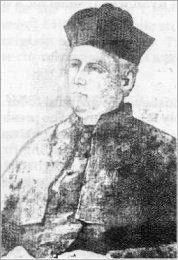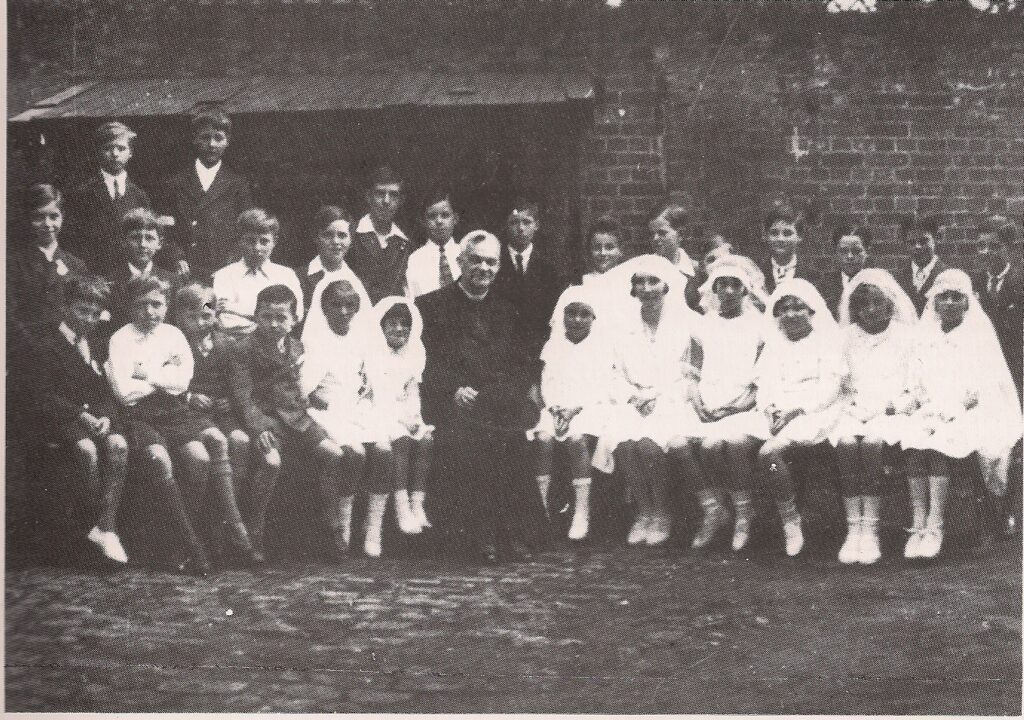
In the beginning
Roughly 110 years ago, New Barnet was served by priests belonging to the Institute of St Andrew, founded by Fr. George Bampfield in 1870.
The priest appointed to say Mass on any stated Sunday would cycle from Barnet and alight at 2 Leicester Road, where he would go upstairs to the room belonging to Mr and Mrs Lyons and there say Mass for 8-12 Catholics.
As numbers increased the overflow would kneel outside on the landing and down the stairs.
In 1904 to cater for these increasing numbers, a loan was taken out and the former Baptist Mission facing the Railway Station in York Road was bought for £800.
It took years to pay off this debt, since the weekly collection in the early days amounted to very little. Admittedly money was worth more in those days, but the Institute always had liquidity problems, because it expanded too quickly, opening more churches and schools than it could easily finance.
Not surprisingly, then, the Institute ceased to exist in 1912. But the names and the pastoral work of Frs Bamfield, Hookway, Graty and Ryder in and around New Barnet will never be forgotten.
To replace them, Cardinal, Archbishop Bourne moved Fr Matthew Lynch (ordained 1902) north from Bow Road where he had spent seven years as curate to become Rector of the small Catholic community still centred on York Road.

According to his obituary in the Westminster Cathedral Chronicle, Fr Lynch had to be understood before he could be appreciated: “outwardly he was often ungracious, outspoken or hesitant, but these were mere signs of super sensitiveness for, beneath the sometimes bluff exterior, there was a heart of gold.” He was particularly noted for his love of the poor and he ensured that there was a very active St Vincent de Paul Society in the parish under the presidency of Mr J. G. Taylor.
Fr Lynch also used to give alms to the needy, but he was shrewd and turned away those who abused his charity. On one occasion an undeserving vagrant asked for the fare to Oxford and Fr Lynch replied, “You’re wasting your time. They don’t take hobos like you at the University!”
During his time at New Barnet he joined a committee to care for Belgian refugees at the outbreak of the Great War. “Turning to Fr Lynch at the first committee meeting, the [non-Catholic] Chairman said, “Their Religion will be cared for by the Rev. Mr Lynch and, I understand, the services will be in Latin. Of course we all know Latin don’t we, Mr Lynch?” The reply came like an arrow, “Utique. Imprimis stultus es!” (“Of course I do! Mainly because I am not an ignoramus like you!” {A very loose translation!}) – “Quite, quite,” said the bewildered chairman to the great amusement of the non-Catholic Clergy and others who, unlike himself, understood Latin.’
With the limited funds available Fr Lynch managed to pay the gas bills for the lighting and pay for the coal which, via a large stove, kept the church warm. These were pre-electricity days, so when he arrived at the church he had to turn on each gas jet individually and then light it by hand. And then there was the question of removing the ashes from the stove and hopefully raking the fire into life, or more often relighting it with the help of paper and wood.
Needless to say he could not do everything by himself, but parishioners often came to his assistance. Mr Winkup was his right hand man as well as organist and choir master, but there were others, many of whose names have unfortunately been forgotten. Charlie Hardie (RIP) who lived nearby was once asked to whitewash the little vestry in the church. This he did, helped by three friends. On completion Charlie was given the princely sum of a shilling and told, “Buy the boys a drink.” Apparently the local brew, McMullens, was fourpence a pint at that time, but cash was not available for a second round.
Confirmation of the tight financial situation is to be found in an excerpt (dated 2 November 1913) from Mr Goodyear Simmons’ diary. “It is just a year since Fr Lynch took over at New Barnet – since then, there have been ten Baptisms, five first Communions, and two deaths. There are about 150 parishioners, of whom about 80 attend Mass. The average Sunday collection is 20-25 shillings. Altar Society about 8 shilling per month. Christmas offering was £3 and the Easter offering £4. Total receipts for the year amounted to about £66.00. The first half of the mortgage was paid by Westminster, and the second half (£9.00) is now due. There will be a special collection next Sunday, and a Whist Drive soon”.
The diary does not mention that the parishioners were also organizing house to house collections to pay for Fr Lynch’s rent, because for all the time he was in New Barnet he lived in lodgings first in Long St, (now Longmore Avenue) and then in Gloucester Road.
Fr Lynch, in his turn, lived frugally and saved what he could: first of all to beautify the chapel and then to buy land in Somerset Rd for a new church and presbytery. In this manner the statues of St Anthony and St Joseph were acquired in 1915 and ten years later the statue of St Theresa. The building of a new church was achieved shortly after Fr. Lynch was moved to Uxbridge in 1937, but he had done much to bring that dream closer to realization.
Fr Lynch, aged 66, died in St Joseph’s Hospice, Liverpool in 1944. His Requiem Mass was celebrated in Uxbridge on 12 September in the presence of Archbishop Griffin.